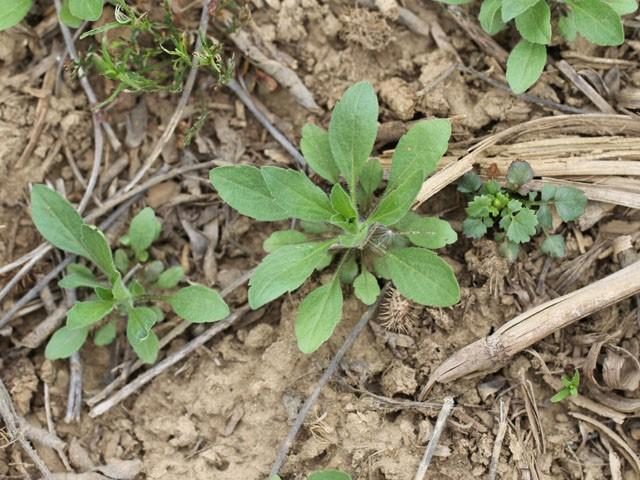If you have never applied herbicide in fall to burn down winter annuals, or done it only infrequently, this might be the year to make an investment in fall herbicides. Fall treatments are an integral component of marestail management programs. They also prevent problems with dense mats of winter annuals in the spring, which can prevent soil from drying out and warming up, interfere with tillage and planting, and harbor insects and soybean cyst nematode. 2019 was a generally tough year for weed control, leading to higher end of season weed populations in some fields. A number of acres were never planted, and growers got to experience the difficulty in obtaining season-long control in the absence of a crop. Reminds us all how important the crop canopy and shading of the soil is during the second half of the season. Bottom line - there was substantial production of weed seed in some fields, and a replenishment of the soil seedbank by both winter annual and summer annual weeds. The seed of winter annuals and marestail lacks dormancy so above-average weed seed production can lead to an immediate increase in fall-emerging weeds. Applying herbicides this fall can compensate for increased weed populations and make life easier in the spring.
We have published information on fall herbicides fairly frequently, and our suggestions for fall treatments have not really changed much. There is plenty of information on fall herbicide treatments in the C.O.R.N. newsletter archive and on other university websites. Our philosophy on this has not changed much over the past decade. A few brief reminders follow:
1. When to spray? Anytime between now and Thanksgiving will work, and possibly later. We have applied into late December and still eventually controlled the weeds present at time of application. Once hard freezes start to occur, there is usually a substantial change in the condition of certain weeds, such as dandelion and thistle, that renders them less sensitive to herbicides. We discourage applications during periods of very cold weather which can occur starting about Thanksgiving, and also (obviously) when the ground is snow-covered. The generally dry conditions we are experiencing have limited weed emergence so far this fall. We anticipate that rain occurring now that leads to some sustained soil moisture near the surface will likely result in germination and emergence of the weeds that have been missing until now. Our recommendation is to wait for rain and the additional weed emergence before applying any herbicide this fall. The risk in this is that the weather turns wet, making it difficult to apply herbicide. So it’s also possible to apply now and include a residual component to help with later fall emergence (which is the exception to the “no residual” recommendation in #4 below), such as simazine, a low rate of metribuzin or Canopy, or a Sharpen rate higher than 1 oz.
2. What about all of the crop residue on the ground after harvest - won’t that cause problems? We have not worried about this, and the herbicides seem to work regardless. Most agronomists I have asked have the same impression. On the other hand, it probably wouldn’t hurt to wait a while after harvest to let the residue settle down, and the weeds to poke through. Dense crop residue usually prevents marestail from emerging anyway.
3. Don’t make it too complicated or pricey. Keep in mind that the primary goal is control of weeds that have already emerged. This is hard to accomplish with a single herbicide, but there are a number of relatively low-cost two-way mixtures that easily achieve this goal. Our philosophy has generally been to start with 2,4-D, and then add another herbicide that results in more comprehensive control. Herbicides that make the most sense to add to 2,4-D based on our research: glyphosate, dicamba, metribuzin, simazine, Basis (and generic equivalents), Express (and generic equivalents), or Canopy/Cloak DF or EX. These allow either corn or soybeans to be planted the following year with these exceptions: simazine - corn next year; Canopy/Cloak - soybeans next year; Basis - possibly restricted to corn based on rate and geography. We do not see the need for three-way mixtures, although a case can be made to add a low rate of glyphosate to a two-way mix to control grass or improve activity on perennials. A two-way mixture of glyphosate and Sharpen could also be used, but we believe Sharpen has more utility in marestail control programs when used in the spring.
4. Is there an advantage to including residual herbicides? No, because almost all of them dissipate over the winter and fail to provide any control of spring-emerging weeds. The primary exception to this is chlorimuron (Canopy/Cloak), which for whatever reason does persist at high enough concentrations to provide some control in spring. Our research has repeatedly shown that applying other residual herbicides in the fall to get control in spring is a waste of money. The good news here is that any effective fall herbicide treatment with or without residual will result in a weed-free seedbed in spring, usually into April, so that the spring-applied burndown/residual treatment just has to control small weeds that emerge in the few weeks prior to planting. That is the goal.






